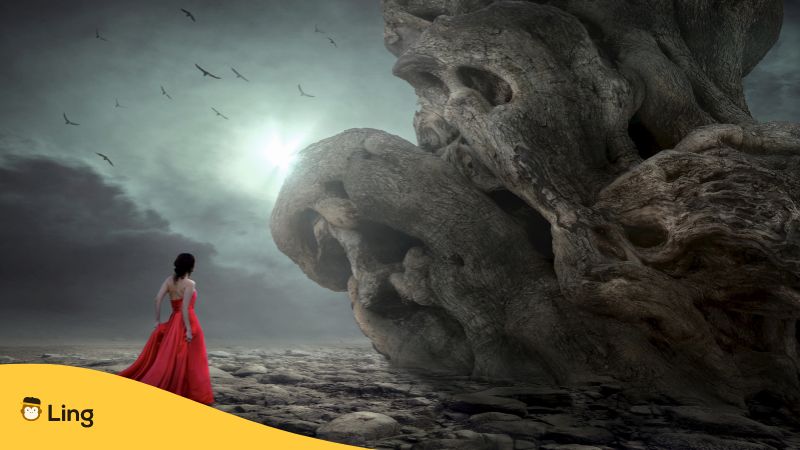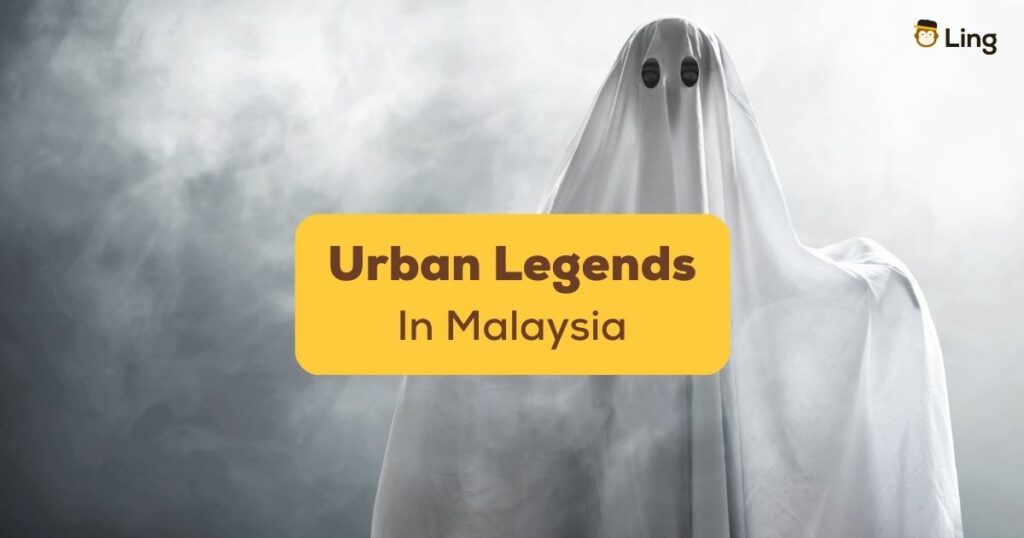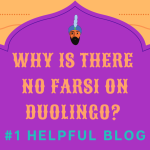Like many countries, Malaysia has its fair share of the supernatural. People love to tell stories of ghosts, spirits, devil possession, and the like – and Malay ghosts are no exception here. These urban legends can scare children (and adults) from here to Karak Highway.
But they’re also something you’ll encounter when you start learning the Malay language, so we’ll give you a head start and tell you all about Malaysia’s most famous urban legends! From the knife-wielding orang minyak to the devil that comes after a pregnant woman at night, you’re in for a scary treat.
So set up your black magic wards and get cozy – we’ll talk about the creepiest urban legends Malaysia offers.
Urban Legends In Malaysia – Best Ghost Stories
1. The Orang Minyak
The orang minyak comprises two Malay words: orang (oil) and minyak (people). It is a supernatural entity described as an oily man (or woman.) The orang minyak is said to prowl the streets at night, seeking its next victims – particularly those who spend time outdoors after midnight.
According to legends, the orang minyak is demonic in nature and can possess the living. After possession, people would act out in violent and irrational ways. Folklore is filled with stories of orang minyak possession, leading to people murdering their friends and family.
However, it is not without a weakness. People believed that you can ward off an orang minyak with the help of some blessed water and religious mantras.
Words To Learn
| Word | Meaning |
| Orang | Oil |
| Minyak | People |
| Air suci | Holy water |
| Solat | Prayer |
2. The Beautiful Woman Dressed In Red

Possibly the most popular and haunting urban legend in Malaysia, the lady in red is said to be the spirit of a mysterious woman dressed in a red dress, known only as Janet. The story goes like this: Janet was a young Chinese nurse working at Sarawak General Hospital, Kuching’s public hospital.
In those days, Kuching City reported a rise in kidnapping cases. Rumors were all around, saying that the kidnappings were human sacrifices made to appease a vengeful spirit preventing the construction of the Satok bridge. Unfortunately for Janet, she was to disappear on her way home from work.
After an exhaustive search, Janet’s headless body was found. Locals tell the story of how her head was embedded into the pillars of Satok Bridge to appease territorial spirits in the area. However, the legends continue about Janet’s ghost, which many have reported seeing as a female apparition with long black hair that haunts Kuching to this day.
Words To Learn
| Word | Meaning |
| Perempuan | Woman |
| Merah | Red |
| Jambatan | Bridge |
| Hilang | Disappear |
3. The Toyol
This mythical creature is said to be a malicious and evil spirit, summoned through the help of black magic. It is one of those old wives’ tales that pregnant women were terrified by, and with good reason: the toyol is created from stillborn infants. It appears naked and screeching, screaming for its mother.
Once summoned, the toyol is said to be a thrall of the person that summoned it. They are known to cause havoc and chaos and sow discord amongst families. However, legend also states that toyol can do small errands and even steal items for their masters. Therefore, it is one of the most iconic monsters in Malay mythology.
Words To Learn
| Word | Meaning |
| Lahir mati | stillborn |
| Mengandung | pregnant |
| Semangat jahat | evil spirit |
4. The Hantu Raya

The Hantu Raya is known as the king of ghosts, with stories that terrified villagers living in the more rural areas of Malaysia. It is said to haunt the jungles and forests of the country. The Hantu Raya is known for causing fear and panic amongst those who dared to go through his territories.
According to legend, the Hantu Raya looks tall and horrifying, with his head reaching the top of the forest canopy. However, that is not its only form. It can also turn into another human being or any animal in the forest it rules over, allowing it to enter a house or avoid being heard.
Its favorite food is ancak – a ritual food made with glutinous rice, chicken, eggs, and rice flakes – which people used to leave at the entrance to the forest. It is said that the offerings must always be placed every week, otherwise, the Hantu Raya might attack a neighboring village or catch one of their young.
Words To Learn
| Word | Meaning |
| Ancak | food offering for spirits |
| Hantu | forest |
| Raya/raja | King |
5. Karak Highway
Regarding urban legends, Karak Highway is one that truly takes the cake. This is known across Malaysia as the most haunted highway in the country. Built in 1970, it was a highway that connected Kuala Lumpur to the exclusive Genting Highlands, only being open to public use seven years later.
It stretches for over 60 kilometers and is known for being long, dark, and winding, the perfect recipe for disaster. And disasters it did provide, with one of the largest crashes happening on this very highway: the 1990 Highway Crash, which claimed the lives of 17 people.
You may sometimes smell the stench of rotting flesh if you drive along the highway at night. There are also reports of a young boy spotted wandering the roadside at night, a driverless yellow Volkswagen Beetle that brake checks dangerous drivers, and even a flying pontianak that targets lone male drivers.
Words To Learn
| Word | Meaning |
| Pontianak | vampire |
| Kereta | car |
| Nahas | crash |
6. The Pocong

It wouldn’t be a story about creepy creatures and urban legends if we didn’t have a white-cloth entity, right? Enter the pocong – a ghost wrapped in a white burial shroud, called a kafan, that floats and jumps around in abandoned places – much like the Chinese version of a ghost.
Legends state that the pocong comes into being when someone dies and is not buried properly. The deceased’s soul becomes trapped in the shroud, turning them into a pocong. While not inherently harmful, their appearance sends shivers down people’s spines. In addition, it prevents the living from entering the abandoned location they call home.
Words To Learn
| Word | Meaning |
| Pengebumian | burial |
| Pocong | ghost |
| Kafan | burial shroud |
Learn Malay And Speak With Malay Ghosts With The Ling App

Now that you’ve become acquainted with Malaysia’s best urban legends, it’s time to take it a step further by learning Malay. You can do that very simply with the Ling App!
We’ve collected lessons made with expert educators and native speakers and put them in an easy-to-follow format for learners of all skill levels! So if you’re looking to learn Malay – whether for fun or business – this app is for you.
Download the Ling App today for Android and iOS and get started on your Tagalog learning journey today.































































